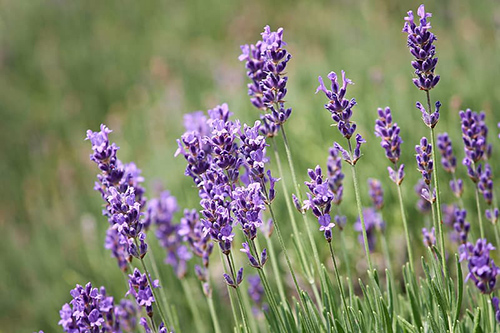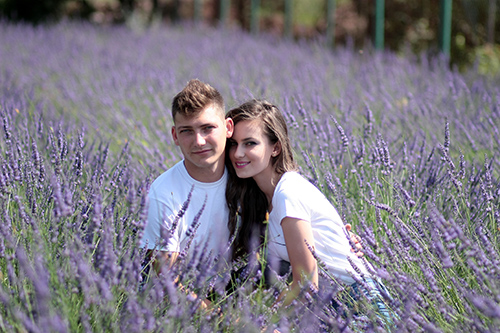Lavender has been used for centuries as a beauty and hygienic product. Lavender benefits were recognized as far back as the Roman Empire; aristocrats and distinguished citizens added the lavender plant to their luxury baths’ water. The name is derived from the Latin word lavare (to wash).
Honey bees also like the lavender plant’s exquisite aroma, and with the nectar of its flowers, they produce exceptionally delicious honey.
How to use Lavender

- Infusion with 30-40 g of flower bouquets and leaves per liter of water. Drink three cups daily, sweetened with honey, after meals.
- Fluid extract. Take 30 drops three times a day.
- Essence. The usual dose is 3-5 drops, two or three times daily.
- Lavender essence. A few drops, inhaled or rubbed on the skin, are enough to produce healthy lavender benefits.
- Cleansing and compressing. The same infusion method for internal use is valid, though it may be prepared with a higher plant concentration. Wash wounds and ulcers directly with this infusion, after which a wet compress may be applied to the affected area for 15 to 20 minutes.
- Warm fomentations. These are prepared with a lavender infusion or by adding drops of lavender essence to water. Apply on the neck, back, and knees.
- Lotions and frictions. These may be applied using a few drops of essence, oil, or lavender water.
Lavender Scientific Facts

- Scientific synonyms. Lavandula officinalis Chaix. Lavandula vera D. C.
- Synonyms. English lavender
- French. Lavande
- Spanish. Lavanda
- Habitat. Calcareous soils in sunny, dry areas of southern Europe. This plant is cultivated commercially in Europe and America for its essential oil.
- Description. The woody-based mint family shrub, Labiatae, grows from 15 to 60 cm high. Gray-greenish narrow and elongated leaves, with little blue flowers which grow in spikes.
- Parts used. Flower bouquets (spikes) generally, and also leaves.
Top Rated Lavender Herbs
Lavender Benefits
Flower bouquets and lavender leaves contain one to five percent volatile essential oil of very complex composition, formed by different terpenic alcohols and their esters (organic compounds). The most important of them is linalool. This essence is responsible for the many valuable lavender benefits, which are the following:
Nervous System
Lavender benefits the central and autonomic nervous systems. It is helpful for people with nervous anxiety, neurasthenia (psychosomatic fatigue and weakness, nausea, blackouts (fainting), heart palpitations, and generally all psychosomatic diseases.
Digestive
It has a slightly carminative (antiflatulent) and antispasmodic action on the digestive tract. It is also an appetizer and eases digestion. The essence also has antiseptic effects. It thus renders good results in cases of colitis (large intestine inflammation), especially when putrid fermentation with rotting feces and foul-smelling gases is present.
Antirheumatic and Anti-inflammatory
In external applications, lavender water, oil, or essence are quite effective in easing rheumatic aches, be they of joint or muscular origin, joint aches be they in the neck or back, gout arthritis, stiff neck, lumbago, sciatica, etc. They are also helpful for dislocations, sprains, bruises, and muscular strains (muscle pulls and stiffness).
Antiseptic and cicatrizant
English lavender infusion is used to wash infected wounds and ulcers, and it helps them to heal quickly. Lavender oil eases the pain of minor burns (first-degree) and helps to reduce the inflammation of insect bites.
Relaxing and Anti-fatigue
After long walks and intense physical exercise or feeling tired, a hot bath with lavender water or essence helps reestablish blood circulation and eliminates the sensation of tiredness. After the bath, better results are obtained when a massage is given with a wool cloth soaked in lavender water, oil, or essence.
Sedative
Merely smelling the aroma of lavender has a soft but effective sedative action on the central nervous system. It is highly recommended for hyperactive children or for those who sleep poorly. In this case, pouring some drops of lavender essence on the pillow or a handkerchief near the face is quite effective.
Balsamic
Lavender essence is used with steam inhalation to help heal laryngitis, tracheitis, bronchitis, bronchial colds, and catarrhs.
Top Rated Lavender Supplements
How to Make Lavender Oil

Dissolve 10 g of the essence in 100 g of olive oil. It may also be prepared by mixing 250 g of the dried plant with one liter of oil, steeping in cold extract for two weeks, and filtering after this time. It is used as a lotion applied to the painful area for lavender benefits.
How to Make Lavender Water
Dissolve 30 g of the essence in one liter of 90% alcohol; after leaving the mixture to rest for 24 hours, filter it with paper and keep it in well-closed recipients. If it is too concentrated, you can dilute it with water.
You can also prepare it by adding 250 g of flower bouquets to one liter of alcohol and steeping it in cold extract for two weeks. After this time, filter through a paper and keep it in well-closed containers. You can use it as an antirheumatic, anti-inflammatory, and relaxant, applied externally in baths and massages.
Warning: Lavender essence, when used internally, must be employed with caution as, in high doses, it may produce nervousness and even convulsions.
DISCLAIMER: All content on this website is presented solely for educational and informational objectives. You should not rely on the information provided as a replacement for advice, diagnosis, or treatment from a qualified medical expert. If you are pregnant, nursing, or have any preexisting medical concerns, you should talk to your doctor before using any herbal or natural medicines.
References
- George D. Pamplona-Roger, M.D. “Encyclopedia of Medicinal Plants.” George D. Pamplona-Roger, M.D. Encyclopedia of Medicinal Plants. Ed. Francesc X. Gelabert. vols. 1 San Fernando de Henares: Editorial Safeliz, 2000. 161,162. Print. [Lavender Benefits]
- United States Lavender Growers Association: https://www.uslavender.org/
- National Center for Complementary and Integrative Health: https://www.nccih.nih.gov/health/lavender
- Mount Sinai Health Library: https://www.everydayhealth.com/diet/what-are-possible-benefits-lavender-must-know-facts-about-therapeutic-plant/
- “The Complete Book of Essential Oils & Aromatherapy” by Valerie Ann Worwood
- “Lavender: The Essential Oil” by Valerie Ann Worwood
- “The National Association for Holistic Aromatherapy” website: https://naha.org/
- “The Essential Lavender Cookbook” by Richelle Brooks
- “The Food of Paradise: Exploring the Healing Traditions of Ayurvedic Cuisine” by Patricia Davis
- “Sunset’s Savory Herb Gardens” by the editors of Sunset Magazine
- “The Complete Guide to Aromatherapy” by Julia Lawless
- “The Healing Power of Essential Oils” by Eric Zielinski
- “Nourishing Hair: A Guide to Healthy Feeding for Strong, Shiny Hair” by Dr. Carolyn Dean
- “The Beekeepers Handbook” by David Winston
- “The Organic Gardener’s Handbook of Helpful and Harmful Insects” by Barbara Hajdusek
- “Rodale’s Pest and Disease Control” by Cynthia Westcott
